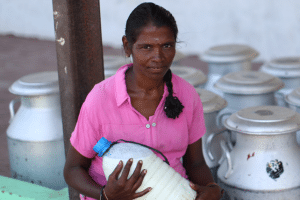MAKING MARKETS WORK FOR THE LAST MILE POOR
The Making Markets Work for the Last Mile (LM4P) approach targets last mile economically excluded areas, where development needs are greatest, and where resources are most scarce, working with market actors to better serve small rural entrepreneurs and small rural entrepreneurs to be equipped to better access and benefit from market opportunities.
How the Approach Works – The Strategic Framework
At the core of the LM4P strategic framework, is the goal for access, agency and advancement of vulnerable women and men through profitable markets in the last mile. Markets are thin in the last mile context and the capacities of the population are low to engage in profitable markets or subsectors. Proper functionining of these profitable markets is important for sustainable economic growth of the last mile population.

The reason for this ineffective engagement are system barriers – both market and and non-market. Market barriers are those that are directly related to the functioning of a market while non-market barriers are those that are not directly related to the market but are reasons why socially excluded, women, men and communities are unable to engage profitably. The LM4P framework acknowledges that in last mile contexts, key barriers to market participation may lie in the non-market Barriers (household focused facilitation) than in the market ones (business or market focused facilitation), while in case of other last mile contexts, this may be opposite. To address these barriers, both market and non-market actors can play a crucial role to ensure sustainability.
Through the approach, programmes will implement systemic interventions using a combination of both ‘lift’ and ‘reach’ strategies that addresses the key market and non-market barriers of the last mile poor. Considering the heterogenous nature of vulnerabilities of the poor, ‘lift’ strategies will be needed to enhance capacity of the poor to become market ready – strategies which may not yet be financially feasible for the actors. Simultaneously, considering market and non-market actors do not have sufficient incentives to engage with the last mile poor, programmes will need ‘reach’ strategies facilitating relevant actors to test and adopt inclusive models with proper incentives to reach the last mile poor. These interventions will need to be designed and sequentially implemented based on the diagnosis of the last mile location and the vulnerabilities of the poor living in it.
The framework further highlights the potential systemic interventions (explained in the table below) that can be implemented to overcome market and non-market barriers of the last mile poor. The interventions presented in the framework serve as a guide and the final decision on how or whether to implement them depends on the selected last mile context and programme resources. Programmes may need to devise other intervention strategies depending on the context.
| Systemic Interventions to address Non-Market Barriers | Systematic Interventions to address Market Barriers |
| Productive capacity – interventions required for improvement of assets, knowledge and skills that the last mile population need, to engage in profitable markets | Last mile market services – interventions to facilitate market actors who can provide relevant market and financial services but need to function better for effective engagement of the last mile poor in profitable markets. The last mile poor usually live in thin markets where many market actors may not “crowd” in because it may not be financially feasible for them to do so. |
| Social protection – interventions to enhance basic needs required for effective economic engagement in profitable markets. This may include access to basic services such as health services, housing facilities, etc. which are critical for survival before the poor can engage in economic activities. | Enabling environment and market agency – interventions to improve rules, policies and other factors in the environment of the last mile poor that affect their economic agency and engagement in profitable markets. |
| Social inclusivity – interventions to advance the state in which the last mile poor can participate fully in economic, social, political and cultural life. People in the last mile usually face power imbalances and unfair treatment due to their vulnerabilities that may be based on low incomes or based on gender and/or physical disabilities or being in the minority/ marginalised groups due to religious/ cast systems. These people often face social exclusion beyond mere exclusion from markets. Without ensuring social inclusivity of these groups in the community, last mile impact will not be sustainable. | Last Mile buyer integration – interventions to facilitate connecting the last mile poor (producers) to the right buyers based on mechanisms providing the poor to access best terms from the buyers. |
DOWNLOAD THE BROCHURE TO LEARN MORE
How the approach was developed
Palmera developed this approach in collaboration with its local partners, after several years of implementing livelihood programmes in Sri Lanka reflecting on the challenges of addressing the complex market and non-market challenges in the last mile locations where we were working. We found that the challenges of the last mile poor were multi-dimensional. People-centered approaches like the Sustainable Livelihoods Approach or pure market-centered approaches like Market Systems Development was not sufficient.
Through a five-year pilot, Palmera expanded on the existing best practice principles and made it more specific for local NGOs/ implementing organisations to follow the keys steps of diagnosis, design, implementation and monitoring of its activities to benefit the given last mile context. The approach that evolved was named LM4P that sets out principles more specific to address the barriers faced by the last mile.
The approach was also piloted in Bangladesh and is now being scaled in Sri Lanka through Palmera.



